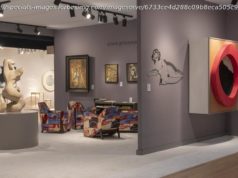Array
In a small New Hampshire tourist town, the front of a roadside bakery is adorned with an image of the sun rising over a row of doughnuts, muffins and other pastries.
Whether that painting is a mural or a sign will determine whether the high school students who created it will see it taken down.
The Conway, N.H., community has been captivated for months by a dispute, previously reported by the Conway Daily News, over whether the art project is considered a sign under the municipal code. The town says yes, because the painting shows baked goods – and that the image exceeds the legal size limit for signs. The owner of Leavitt’s Country Bakery says no – and, in a federal lawsuit, contends the town ordinance violates the First Amendment.
“We didn’t want to take the mural down,” said the owner, Sean Young. “At first I was just upset for the kids, and I didn’t feel that they were right in telling us that it wasn’t art.”
Later, Young said, the disagreement became a matter of principle. In the lawsuit filed last month, he argues that the ordinance is unconstitutional. The suit claims that because the law defines a sign by what images it shows, it discriminates based on the content of the speech and the identity of the speaker.
Conway officials say they are upholding the will of the citizens who voted to pass the sign ordinance, and they point out that they have not enforced the rule against Leavitt’s through fines or other consequences.
The saga began last spring, when a friend of Young’s heard that another friend, local art teacher Olivia Benish, wanted to get her students involved in the town and noticed the bakery was essentially a blank canvas. Young had bought the decades-old Leavitt’s, once deemed “the unofficial town hall of Conway,” in 2021 and quickly led it to the prime spot on a list of best doughnuts in New Hampshire.
When he connected with the five Kennett High School students, he gave them free rein to create any image. The team talked about the need to avoid painting the Leavitt’s name or logo on the mural, Benish said. They did not want anyone to confuse it for a sign.
“I thought we were aware,” the teacher said. “Obviously, I was not completely aware, because I had never imagined it becoming what it has become.”
Benish brought Leavitt’s doughnuts to school one day, and the group began brainstorming. They considered ideas centered on the character of their northeast New Hampshire region, which attracts skiers in the winter and hikers and water tubers in the summer.






